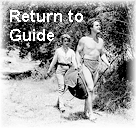- MGM sold the Tarzan rights to Sol Lesser and Weissmuller and you moved to RKO to continue the series, how did that differ from the MGM days?
- RKO Pathe is also in Culver City and going to work there each day we traveled the same rout from Brentwood where we lived that we formerly covered going to MGM. The studio has a southern plantation look to the front with many offices. The soundstages are right behind the front offices and behind that lies the backlot.
I was given a permanent dressing room on the lot and was treated very well by everyone there. The big difference between MGM and RKO was SIZE. MGM had more and bigger everything. Metro was still GROWING when I was there. They were working on new executive offices and had just completed Stage 15, the largest soundstage in Hollywood or anywhere else.
Pathe had a main gate and two or three soundstages, but nothing like Metro. At MGM there were many contract stars working on the lot and plenty of activity all the time. We were all sort of family. At Metro the school age actors, (Judy Garland, Mickey Rooney, myself and others) attended school, from 9:00AM to noon, daily in our own school house presided over by Miss McDonald. Most companies broke for lunch about noon and it was fun eating together in the studio cafeteria. Pathe had no cafeteria; we ate off the lot.
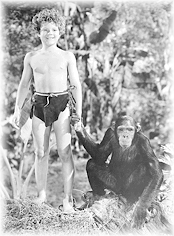 I missed not having my own ZOO at RKO Pathe. At Metro for several weeks before shooting I always spent the morning before school and afternoons with George Emerson and the animals. George was the BEST wild animal trainer in the business! He was responsible for training all the animals. He trained me too. George used to tell me that, "I was a good kid, but the woods are full of good kids. These cats just barely tolerate you so, heads up." This daily exposure was required by the Studio in an attempt to minimize the danger working with Leo and the lion cubs, Jackie & Joe - Cheetah(s), Sally, Happy and Queeny, my baby elephants, and the other wild animals called for in the scripts.
I missed not having my own ZOO at RKO Pathe. At Metro for several weeks before shooting I always spent the morning before school and afternoons with George Emerson and the animals. George was the BEST wild animal trainer in the business! He was responsible for training all the animals. He trained me too. George used to tell me that, "I was a good kid, but the woods are full of good kids. These cats just barely tolerate you so, heads up." This daily exposure was required by the Studio in an attempt to minimize the danger working with Leo and the lion cubs, Jackie & Joe - Cheetah(s), Sally, Happy and Queeny, my baby elephants, and the other wild animals called for in the scripts.
It was great working at RKO Pathe. Our "Company" always had it together. We had everything we needed. Big John and I were together. We did our job and had a lot of fun. We even had George Emerson and Jackie on "loan out" from MGM for a while.
The big difference was size and all the exciting entertainers and activity that was going on with the other companies working on the lot at MGM; we didn't have this action at RKO Pathe. Going to school with Mickey and having lunch with the likes of Walter Pigeon and Wally Berry isn't all that bad! In that respect RKO was a change.
Whether at MGM, RKO Pathe, or Monogram, I always had great support from the studio, the producer, the director, the head camera man, the cast, and the crew. For me the adventure of being Boy and living with Tarzan really didn't depend on where we were working. I was doing my thing. It's all about who you are working with. I always had the best!
- Brenda Joyce followed Miss O'Sullivan as Jane, tell me about her.
- I was young and Maureen was gone. My father knew I was going to miss her and perhaps be unkind and say things such as "you will never take the place of my real jungle mom," or do things I would regret later. He explained that I was a professional actor and that "Jane" wasn't gone any more than "Boy" was. He told me that Maureen was not gone and that she would always be a part of my life. He was right.
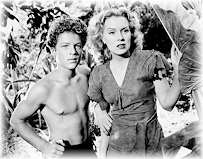 When I separated the individual personalities from the character and got into the part there was no problem and I had learned a great lesson. Maureen wasn't gone; she just wasn't Jane anymore. Father helped me with the fear of working with a new Jane. There were to be no comparisons; I was to have a new jungle family. I realized that my early Boy years were over and this was going to be a new experience. I was looking forward to being with my NEW Jane.
When I separated the individual personalities from the character and got into the part there was no problem and I had learned a great lesson. Maureen wasn't gone; she just wasn't Jane anymore. Father helped me with the fear of working with a new Jane. There were to be no comparisons; I was to have a new jungle family. I realized that my early Boy years were over and this was going to be a new experience. I was looking forward to being with my NEW Jane.
With Maureen I related more to Jane as a child. I was fourteen now and grown up enough to "notice" how attractive Brenda Joyce was. That seemed very natural to me, Boy was relating to Jane not so much as a mother, but as a woman. This was going to be a pleasure.
Brenda was sincere in her portrayal of Jane and she was always considerate and kind to me. We got along swimmingly from the start. I think you can see that in the films. I now had Brenda Joyce to tuck me in and kiss at night. Does it get any better than that?
- Following your departure from the Tarzan series, you were cast as Bomba. What were the circumstances behind this move?
- I outgrew the part of Boy and it was time to say Umgawa to my first jungle family and take all those good years of training and move out on my own. Walter Mirisch was just beginning his movie career as a producer at Monogram and he wanted me for a jungle series based on Roy Rockwood's character. The role looked like a natural extension for my jungle career and would allow me to continue my studies at U.C.L.A.
I went to Monogram Studios to meet with Walter and we hit it off, so he took me down the hall to Steve Broidy for approval. I remember Steve asking Walter if "this," meaning me, was what he wanted. Walter said yes and that began my career of seven fun years at Monogram/Allied Artists with producer, Walter Mirisch, Ford Beebe, and Johnny Martin, my camera man. I moved from a jungle penthouse to a cave beyond the Rift, it was very SPECIAL, like the Escarpment, and it was my new jungle home.
- Many of the Bomba movies (especially the later ones) seem to imply that Bomba is really Boy all grown-up. For example, supporting characters often refer to Bomba as an ape-man (Bomba was not raised by apes), the use of many of the Tarzan phrases (Umgawa, etc.), and even Bomba's favorite elephant is named Buli (as was Boy's baby elephant). Was this a conscious decision by the movie-makers or was it something you added?
- I suppose in a way it's true that Bomba was Boy all grown up. I was Boy and I was growing up so it followed that Bomba was an extension of Boy, within the constraints of the script and Ford's direction.
It is made pretty clear early in the series that Bomba (meaning a small package in Swahili) was brought up from age 2 yrs. to 7 yrs. by the misanthrope named Cody Casson who lived "beyond the Rift." To my knowledge the series never suggested that Bomba was brought up by apes; for that matter, neither was Boy. So the reference by some supporting characters to Bomba as "some kind of ape-man" probably stems from that character's knowledge of Tarzan and jungle lore! The spirit of Tarzan runs strong in many jungle movies - especially in Bomba!
It's difficult to get around anywhere without Umgawa as a part of your vocabulary. It is hard for me and was especially hard for Bomba! I know people all over the world who use the word every day. Just because Umgawa is not in the American Heritage Dictionary, doesn't mean it's not part of the language.
Now Buli (a teapot in Swahili), is another story. I called all my baby elephants "Buli" after "Baby Bea," my very first baby elephant at Metro. She was named "Bea" after George Emerson's wife. Using "Buli" was a conscious decision on my part.
- What was it like to work with Ford Beebe? How did he differ from the directors you had worked with previously?
- Ford Beebe had a full head of white hair and penetrating blue eyes that were warm and twinkled. When on the set he wore zip-up soft leather boots and a wide-brimmed white felt western type hat.
Ford knew his stuff and was respected by all the crew. He was in charge; not in an overbearing or pompous way, Ford wasn't like that. He was friendly, listened to suggestions, and he didn't nitpick about a shot. It didn't have to be exactly as he saw it in his head. If the scene got the point across, he would print it.
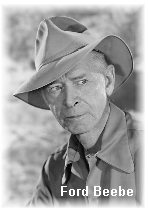
There were exceptions when Ford would want to do the shot again as he felt that something important was missing, but for the most part three takes were rare for us. The crew called me "One Take Johnny." Ford didn't have to make a complete master shot of each scene. He would let the long shot go until he had enough for the "cutter" to work with. Ford had the film all cut in his head and didn't need the expense of shooting a lot of extra footage that would never be used in the film. Ford knew his stuff and got right down to the business of making a movie on a budget.
I met Ford for the first time, "on the set," the morning of the first day of filming "Bomba the Jungle Boy." I said farewell to Ford seven years later, "on the set," in the evening after completing "The Lord of the Jungle." It was always the same.
When Ford had the "set up" ready for the first scene of the picture he would call for me and we would meet center stage. We shook hands, I would say "Good morning, Ford" and he would reply "Good morning, Johnny. Are you ready to go to work?" I would say yes and then it began. After Ford OK'd the last scene of the picture and the assistant director said, "Print it," Ford would always take me to center stage and say, with a grin, "There, Johnny. We've done it again! Contact your agent." I would always reply, "Thanks, Ford. It's been a pleasure working with you. We will have to do it again sometime." After this exchange we would go our separate ways.
Ford had it all in his head. He got the shots he wanted and the angles he wanted without shooting everything from every angle. This was in sharp contrast to what Mr. Dick Thorpe was permitted to do with MGM money. At Monogram we had to be fast. The director had to know what the next set up was going to be and communicate that to the crew clearly and decisively.
Ford worked well with people on the set. He was open to suggestions and he could compromise or change his position. He was good working with the animals. He worked his story around available stock footage. He liked to have a good time, but he was all business when he was shooting. There were no retakes after the film was completed. We had to get it in the "can" the first time around.
I remember an incident on location in Bronson Canyon that illustrates how we all worked together. Ford wanted a "down shot" from the top of a peak that looked down on the action at a cave entrance below. This location has been used a million times in the movies especially in Westerns.
Ford knew the area in detail and he knew exactly what he wanted. The down shot was to be taken over my shoulder so I had to get ready for the climb along with the camera crew. The Mitchell (the camera) was placed on a tripod so the crew could carry it up to the top of the peak. It was not going to be easy to get up there with all the equipment even though we were taking only the essential stuff with us. It seemed like it took us an hour to get up there and set up.
We had to coordinate the action below to my action of appearing in the corner of the frame. There was a little haze so Johnny Martin, before we left on our climb, decided we would use an "Arrow 2" filter to cut the haze. No more was said about the filter until we were in position getting ready to shoot. Martin was going over his check list before we "rolled." "Batteries, camera, film, light reading, lens setting, filter" pause - "FILTER?"
The assistant camera man turned red and said, "Oh, the FILTER!" Everyone broke out laughing and I think Ford laughed the most. It was getting late and the light was going and it was going to take 40 min. or more to go get the 6 oz. filter and get it on the camera so we could make the shot. Time is money and Ford could easily have "gone off," but that was not his nature. He asked the camera man if we could shoot without the filter. Martin said he could shoot without it, but the results would be much better using it. Ford didn't like delays, but in this case he wanted the shot and said, "All right, get the filter."
From then on whenever anything held us up someone would say: "Oh! The FILTER!" and those "in the know" would have a great laugh. That would break the tension. Newcomers would ask, "what was that all about?" We would explain, but unless you had climbed up that peak in the fading light and moved into position to shoot only to find that you were stopped cold by an "Arrow 2" Filter, I don't think you will really understand. Most thought they did and laughed with us. I still think Ford laughed the hardest. We got the shot and it was GREAT.
Ford had a million stories, but he held back and did not take center stage or blow his own horn. He never let his ego get in the way of his work. I think he was a special guy and a hell of a movie maker.
How did he differ from my other directors?
They all did a great job working within the constraints they were given. Some say budget has a lot to do with the directors' performance. I don't think budget had much to do with Ford's ability to make movies.
- What is your favorite Tarzan movie?
- I don't like to play favorites when it comes to the movies I was in. I love them all!
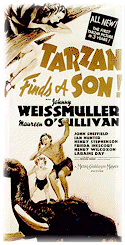 Bearing that in mind, "Tarzan Finds a Son," naturally, is my Straight Ahead FAVORITE. It was the beginning. I got my first baby elephant, Bea, rode in my first private railroad car to location in Florida, I was introduced to my fabulous tree house home, I got my own chimps to play with, I got to feed daily, for a time, Leo the Metro Goldwyn Mayer lion, I was present when my contract was negotiated with Sam Zimbalist, and I personally picked up my first movie check! These were all firsts and wonderful events in my life that happened before and during the filming of "Tarzan Finds a Son."
Bearing that in mind, "Tarzan Finds a Son," naturally, is my Straight Ahead FAVORITE. It was the beginning. I got my first baby elephant, Bea, rode in my first private railroad car to location in Florida, I was introduced to my fabulous tree house home, I got my own chimps to play with, I got to feed daily, for a time, Leo the Metro Goldwyn Mayer lion, I was present when my contract was negotiated with Sam Zimbalist, and I personally picked up my first movie check! These were all firsts and wonderful events in my life that happened before and during the filming of "Tarzan Finds a Son."
I learned spiritual things from my jungle father. When I was small and learning to stand and fell, Tarzan didn't say, "Jane, Boy no good, can't stand up. Throw Boy off Escarpment!" No, my jungle father helped me to stand. When I couldn't swim, my jungle dad didn't say, "Boy no good, can't swim, let him drown!" No, Tarzan taught me to swim. When Boy got out of line, Tarzan was there to point it out. "Boy, Bad!" Then in a twinkle of dad's eye I was forgiven and we went on to experience more of this life adventure.
From these events I learned spiritual values. From the things I could see, feel, hear, and touch, I learned about what I could not see, feel, hear or touch. I learned that I had a spiritual father who loved me and that I could always count on him for guidance and protection; all I had to do was call. I learned then and know now when and how to call for backup, thank God.
There is one scene that stands out as one of my all-time favorites. I was the HERO and had the chance to carry the ball and "run to daylight." Mother and I were in a mess. We were made to cross Zambeli country and you just don't do that! We got ourselves captured. You know the sequence.
The bad guys were being executed all around us and we were NEXT! Things looked pretty grim! We were being held in a hut within a great stockade. Jane saw one of our monkey friends going through the stockade and thought our only hope was for me to get through to Tarzan for help.
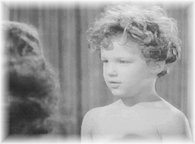 She didn't want to expose me to the danger and she didn't want us to die either. What a situation! It was really heart stopping for me. The "process screen" was set up right outside the Hut window and the Zambeli were carrying the doomed right by us. That's REAL for a 9-year-old. Mom got really emotional and said a lot of "gushy stuff" and finally sent me. I said, "of course I can" and went on her signal, without looking back.
She didn't want to expose me to the danger and she didn't want us to die either. What a situation! It was really heart stopping for me. The "process screen" was set up right outside the Hut window and the Zambeli were carrying the doomed right by us. That's REAL for a 9-year-old. Mom got really emotional and said a lot of "gushy stuff" and finally sent me. I said, "of course I can" and went on her signal, without looking back.
I didn't know then that she was ready to sacrifice herself for my freedom. I ran like a pro, with the spears flying all around, straight across the clearing to the stockade opening. It was for all the marbles and I came through like the "Son of Tarzan." I covered land and water and surmounted all kind of obstacles. I even fought a lion.
I remember asking Walter Pigeon one day in the MGM Commissary where everyone had lunch together if he really jumped out of the airplane and parachuted down into Germany in "Man Hunt." He replied with his own question: "Johnny, did you really fence that lion in Tarzan Finds a Son?" I said, "Of course, I did!" and we both had a great belly laugh!
Anyway, getting back to Tarzan and getting him out of trouble gave me great personal pleasure and the memory of past successes like that help me when the chips are down today. I learned to first write the desired outcome in my personal script. Then all I had to do was follow the script!
I got through and Tarzan organized the elephants in force and we all went to rescue Mom.
Mom, I like that. I can say that about Jane because I AM Boy.
This was a special time in my life and all of it made a lasting beginning for me in the movies and that's why "Tarzan Finds a Son" is my favorite Tarzan movie. If it's yours too; I pray that I had something to do with it!
- And your favorite Bomba?
- "Bomba the Jungle Boy" was my first in the series and holds all the memories that make it my favorite. After all, here was the big test; could Johnny Sheffield carry his own show. It was my first show and it made a profit. Walter put together a great movie team to get the story on film. We all worked hard to make a success of it and we were able to accomplish this while working under rigid budget constraints. We suited up, showed up, hit our marks, found our lights and knew our lines.
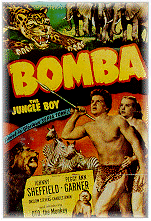 "Bomba the Jungle Boy" was the first and we got so much out of so little. Me and Peg Ann, she was a proven actor, did a good job and Walter M. did an excellent job getting the most for his bucks using stock footage, special effects, silhouettes and backdrops. I can remember coming on stage my first day at Monogram, being greeted by Walter and introduced to Ford, Johnny Martin and the crew.
"Bomba the Jungle Boy" was the first and we got so much out of so little. Me and Peg Ann, she was a proven actor, did a good job and Walter M. did an excellent job getting the most for his bucks using stock footage, special effects, silhouettes and backdrops. I can remember coming on stage my first day at Monogram, being greeted by Walter and introduced to Ford, Johnny Martin and the crew.
I recall the impression I got when I looked around the set. This was not an MGM set. Only the essential elements of the jungle were there. Lines of grass spaced several feet apart, large painted tree cutouts silhouetted against a painted backdrop of the Rift on the horizon and sky beyond stood before me. It was all in perfect perspective, and looked cheap, but I could see that the camera would pick it up as a great African plane. This was Show Biz!
I remember seeing gas burners set between the grass rows and asking myself, "will this work?" This all happened pretty fast as I walked on the set. That jungle really caught fire on the screen! I was really impressed and became a believer when we watched the rushes.
We shot the entire film on one stage. Do you remember the river scenes and the swimming hole? At the end of the picture the crew started heating the water in the 20 by 20-foot water tank below the stage floor. The cover was taken off and the appropriate scenery would be set up along its edge. We shot all the water scenes in "Bomba the Jungle Boy" right there! In later episodes we got outside and I was able to swim flat-out the way Tarzan taught me, but in my favorite Bomba we did it all in a 20 by 20-tank in the stage floor!
Ford Beebe was a wonder, he wrote, produced and directed later episodes. Johnny Martin was my camera man for the series. It is important to have a camera man on your side. He always "stayed with the money" as we say in the business. It was the same with all the crew. Walter was a pal and a great help to us all.
I loved the dialogue in "Bomba the Jungle Boy" and will never forget when I got Peg Ann to my cave and she looked at me and then around my digs and said, "Very cozy!" She looked really great when I finally got her dressed properly. Why she wanted to run from me I could never understand. The entire cast did a great job and we shot the movie in 7 or 8 days.
I had fun making them all, but "Bomba the Jungle Boy" was our first and it will always be special to me and that's why it is my favorite Bomba.
